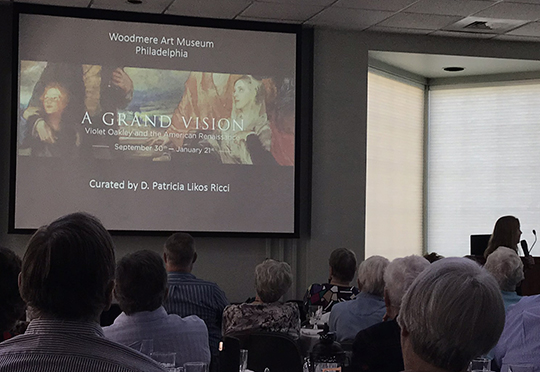 The art of Violet Oakley is as beautiful today as it was game changing at the turn of the last century. In an April 23 talk, Patricia Likos Ricci explained Oakley’s influence as the first female artist to receive a commission for a civic building. Ricci is associate professor of the history of art and director of the Fine Art Division of the Department of Fine and Performing Arts at Elizabethtown College.
The art of Violet Oakley is as beautiful today as it was game changing at the turn of the last century. In an April 23 talk, Patricia Likos Ricci explained Oakley’s influence as the first female artist to receive a commission for a civic building. Ricci is associate professor of the history of art and director of the Fine Art Division of the Department of Fine and Performing Arts at Elizabethtown College.
Ricci’s presentation was the third and final in the College’s “Presidential Community Enrichment Series,” in which E-town opens its doors to the campus community. Mark Clapper, executive director of college engagement opportunities, introduced her.
Ricci began her talk by introducing Oakley as an artist — a stained glass designer, portraitist and muralist — as well as a peace activist. An avid advocate for world peace, Oakley was born in 1874 and died in 1961, living to see both World Wars during her lifetime. Ricci said, at the beginning of Oakley’s life, she lived through the “Gilded Age,” but had a distaste for the period’s excess. Instead, Oakley preferred what Ricci called a “Golden Age,” because of her idealistic and utopian ideals for American society. These ideals are portrayed in her art.
Oakley was an amazing person and a pioneer for women artists.”
Oakley’s murals can be seen in Pennsylvania’s state capitol building in Harrisburg, a “handcrafted building” as Ricci put it, because many artists were hired to take part in its development and decoration.
Though Oakley was the first female to be honored in this way, she was given a smaller room — the 40-foot-long Governor’s reception room — to complete. As Oakley was the breadwinner for her family, failure was not an option. She was given $20,000 and four years to complete her murals, and she was one of the few artists to complete her project on time. She chose to portray William Penn’s life, but knew little about his and Pennsylvania’s history, so she used part of the $20,000 to take her mother and herself to England to learn more about Penn and the persecution that was experienced by the Quakers.
Oakley was so fascinated that she wrote her own history about Penn and the Reformation of the Church. She came back to America and painted murals such as “The Foundling of the State of Liberty Spiritual,” “Intolerance and Persecution” and “The Trial of Penn.” Oakley “believed in the power of images,” as Ricci said, and did not use violent or negative images because of this. Her murals, instead, were hopeful and graceful.
Later in her lifetime, after the death of the chief muralist at the State Capitol, Oakley was chosen to replace him. She was paid $100,000 for the position, which was a huge sum of money at the time. This was also a significant feat for Oakley because it showed how many of her male counterparts accepted her. When asked about this during the question-and-answer portion of the presentation, Ricci said that many of Oakley’s peers accepted her, and those who didn’t simply ignored her. The architects who hired Oakley showed support for her art.
Audience member Michelle Clapper, who has visited the home of John Huston, an E-town alum who is a collector of Oakley’s art, said she found the talk thought provoking. “It was interesting to see the connection to that home and learn about what’s in our backyard,” she said.
According to Ricci, who has a personal connection to the artist and her art, “Oakley was an amazing person and a pioneer for women artists. … I became involved in studying Oakley when I was a student. I interviewed Edith Emerson, Oakley’s former student at the Pennsylvania Academy of the Fine Arts and lifelong partner, who was then in her 80s. She lived in Oakley’s studio in Philadelphia and asked me to help her catalog Oakley’s work. We arranged for the work to be given to museums when Edith died. She was an artist also and an art history teacher. She was a great source of inspiration for me.”
Ricci recently helped to curate an exhibit about Oakley at the Woodmere Art Museum, called “A Grand Vision: Violet Oakley and the American Renaissance.” The exhibit was held from September 2017 to January 2018. In addition to being a “retrospective” of Oakley’s work, it also was a tribute to Emerson, who had once been a director of the museum.
Elizabeth McIlhenney bio:
Elizabeth McIlhenney is a junior English literature major with minors in creative writing and art history. She is co-editor of Elizabethtown College’s “Fine Print Literary Magazine” and is president of Sigma Tau Delta English Honor Society and Creative Writing clubs on campus. She hopes to either write for companies online or pursue a master’s degree in library science or marketing.

